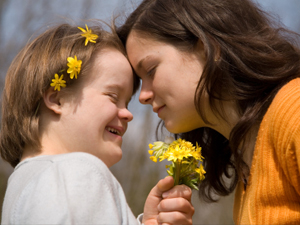 After waiting nearly three years to dig through Sarah Palin’s 13,000-plus old emails, journalists searching for juicy headlines from her brief tenure as Alaska’s governor were left empty-handed. The 300 pounds of printed correspondence dumped on the public this month revealed little new information aside from Palin’s fondness for exclamation points and faux-curse words like “flippin’.”
After waiting nearly three years to dig through Sarah Palin’s 13,000-plus old emails, journalists searching for juicy headlines from her brief tenure as Alaska’s governor were left empty-handed. The 300 pounds of printed correspondence dumped on the public this month revealed little new information aside from Palin’s fondness for exclamation points and faux-curse words like “flippin’.”
A notable exception was the letter Palin drafted for her family shortly before giving birth to her youngest son, Trig, at age 44. Writing in the voice of God and imagining what he might say about this child diagnosed prenatally with Down syndrome, Palin described Trig as a “gift” who would bring his parents “more challenges, and more joy, than what they ever may have imagined.”
“This new person in your life can help everyone put things in perspective and bind us together,” Palin wrote, adding that “those who love him will think less about self and focus less on what the world tells you is ‘normal’ or ‘perfect.’ … Some of the rest of the world may not want him, but take comfort in that because the world will not compete for him. Take care of him and he will always be yours!”
Some readers mocked Palin’s letter as pious pap. Others, including some Palin critics, expressed admiration for her decision to view her son’s condition as a conduit for grace rather than a curse.
Count Eileen Haupt and Leticia Velasquez, two mothers of daughters with Down syndrome, among the latter. The pair recently founded an organization known as Keep Infants with Down Syndrome, or KIDS. Their goal: to encourage expectant parents of Down-diagnosed babies by spreading the word about research advances and the joy these special-needs children can bring.
The potential audience for their message is vast. Today, many women are bearing children later in life and thus facing higher odds of a prenatal Down syndrome diagnosis. (A 20-year-old woman has a one-in-2,000 chance of conceiving a baby with Down syndrome; for a 40-year-old woman, that chance is one in 100.)
Given those odds and the fact that people with Down syndrome are more integrated into the community than ever before, one might expect to see children with Down syndrome everywhere. Instead, most of us rarely see them at all. So where have they gone?
The answer, of course, is that most children diagnosed with Down syndrome never make their debut outside the womb. The combination of prenatal testing advances and the rising use of elective abortion to eliminate “imperfect” babies has decimated the Down syndrome community. According to a 1999 study published in the journal Prenatal Diagnosis, 92 percent of children diagnosed before birth with this chromosomal abnormality are aborted.
That abortion rate soon could climb even higher. Researchers say that within a year, expectant mothers may be able to take a simple blood test as early as their ninth week of pregnancy to detect Down syndrome as well as a child’s future height, risk of depression and chances of developing Alzheimer’s disease. If mothers do not like what they learn, they can abort before anyone suspects they are pregnant.
Hailed by scientists as “a game-changer” and “the Holy Grail of prenatal screening,” the new test has Down syndrome specialists like Dr. Brian Skotko of Children’s Hospital Boston worried. In a 2009 Archives of Disease in Childhood article, Skotko noted that many physicians and health care providers are not adequately prepared to deliver a difficult prenatal diagnosis. They often provide “incomplete, inaccurate, and, sometimes, offensive information” about Down syndrome, Skotko said, and sometimes exert pressure on patients to abort.
Haupt and Velasquez know all about that misinformation and pressure, because they spend their days combating it.
“Things have never been better for children with Down syndrome — and adults,” Velasquez said, when I interviewed her and Haupt in St. Louis recently. “They’re getting married, holding jobs, and they’re breaking all kinds of barriers … They’re granted equal access in educational settings. And they’re blossoming.”
Their progress is threatened by a reinvigorated eugenics movement that regards unborn children with Down syndrome as disposable and treats abortion as a cure for genetic imperfection. Velasquez and Haupt worry about a society that holds such contempt for their daughters, the children who have taught them to slow down and enjoy life, taught their siblings compassion and an appreciation for diversity and taught their families to savor each day as a gift.
“Prenatal testing can tell you a lot,” Haupt said. “But it can’t tell you the joy that your child is going to bring you. And it isn’t just patience. It’s true joy.”
What a shame that we are extinguishing that joy little by little, as we silently destroy the very lives most capable of teaching us unconditional love.
(© 2011 Colleen Carroll Campbell)



